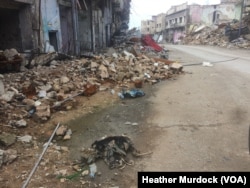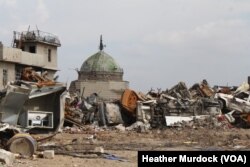Crushed under rubble and burned out cars, dozens, or perhaps hundreds, of corpses of Islamic State militants still lie where they fell in the battle for Mosul’s Old City that ended last July..
In the final throes of the fight, Iraqi authorities dug tirelessly, searching for the bodies of civilians. Over the course of the months-long war, thousands of the dead were recovered. About 70 people were pulled from the wreckage alive.
Authorities, however, made a point of ignoring the corpses of IS militants. They said those bodies should be thrown out with the trash.
And in the hot final weeks of battle, the smell of rotting flesh permeated the air in the Old City as it was pounded with airstrikes and bombs. Soldiers threw blankets over corpses to mitigate the smell.
Now, as families try to rebuild, local authorities are slowly collecting the remains of the IS militants and transporting them out of the city for burial. Residents say besides being a small step toward making the area livable again, it is the right thing to do.
“We are Muslim and believe they should be buried,” says Saad Abdelrahman, an Old City homeowner. “God will judge them for what they did to us.”
Abdelrahman’s house is badly damaged but not destroyed like much of the area. And for the most part, local people here are left on their own to rebuild, without assistance from international organizations or the government. Even the recovery of bodies, he says, is a joint venture between authorities and returning residents.
“Those over there were pulled out of the mosque,” he explains, pointing to four bodies lying on a sidewalk covered in debris. “They put them there so either the government or an aid organization will take them away.”
Horror amid horrors
In a city that has suffered a seemingly endless stream of tragedies over the past four years, no one area has suffered more than Old Mosul.
Under IS militants' rule, it was the heart of their self-proclaimed “caliphate” in Iraq, home of the now-destroyed al-Nouri Mosque, where Abu Bakr al-Baghdadi once declared himself “caliph.” And as Iraqi and coalition forces wrested back the city block by block, militants who didn’t flee or die retreated into the Old City until they were completely surrounded.
Months of siege and airstrikes followed, and families - many who had been forced to retreat to the Old City with IS to serve as “human shields”- starved as they were bombarded.
In the final days of battle, survivors fled, often saying they couldn’t hide from the bombs because they ran out of water and were close to dying from thirst. After they made it to relative safety behind Iraqi lines, babies died in their mothers’ arms, children and old people were treated for gunshot wounds, longed-for bottles of water were gulped down and thrown up.
Now, residents say they are entering a new phase of horror. They are free from IS tyranny, but remain completely neglected, says Aymen Abdulsalam, who had a small shop selling soaps before IS. The city may be slowly clearing the bodies and the rubble on the streets, but families are left to their own devices to repair the homes destroyed in battle.
“A month or two ago some aid organization registered everyone, and said we were going to get some financial support,” Abdulsalam explains. “But we never heard anything about it again.”
The feeling of neglect is widespread, and many other residents say they are angry that what was hailed as a resounding international victory has left them homeless, broke and their neighborhood still sticky with blood and bodies.
“We are not afraid of anyone anymore,” says Abdulsalam. “If the prime minister (Haider al-Abadi) comes here, I will say it directly. We are not being served.”















